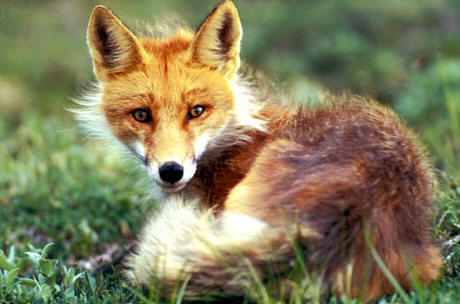_WOB%20(1)%20(740x350).jpg)
Classification
Domain: Eukarya
Kingdom: Animalia
Phylum: Chordata
Class: Mammalia
Order: Carnivora
Family: Canidae
Genus: Vulpes
Species: Vulpes vulpes
Below is an explanation of how Vulpes vulpes fits into each taxonomic ranking. Each phylogenetic classification holds specific qualifications which are characteristic of all organisms put into that category. In each of the categories below, the characteristics listed are shared by Vulpes vulpes. The red fox is much more unique and specialized than these shared characteristics imply, read more in adaptations! ____________________________________________________________________
Domain Eukarya
Members of this domain are united by having membrane-bound organelles as well as a nucleus with a nuclear envelope. Being a Eukaryote classifies Vulpes vulpes with poison ivy.
Kingdom Animalia
Organisms in the kingdom Animalia are more commonly known as "animals." Animals are all multicellular, heterotrophic (meaning they ingest the organic molecules of carbon and nitrogen in their food for nourishment), capable of movement sometime during their life, lack structural cell walls and exhibit the gametic life cycle. Did you know that snails are animals too?
Phylum Chordata
Chordates have bilaterally symmetric bodies that are longitudinally differentiated into a head, trunk and tail. At some time during their lives members of the phylum Chordata have a notochord, nerve cord, pharyngeal pouches (gill slits), a postanal tail and endostyle (thyroid gland). Another example of a chordate is the slow loris!
Mammals are vertebrate animals who feed their young with milk produced by mammary glands. All species under this classification have hair at some point in their lives, even whales! The phylogenetic tree to the right represents the relationships between several members of the class Mammalia based on genetic evidence. The red fox, as you will read below, is a part of the order Carnivora.
Order Carnivora
Species classified under the order Carnivora have specialized teeth well as strong jaws used primarily to eat other vertebrates, however not all members are carnivorous, a common misconception. Members of Carnivora also have adaptions for agility and running, a large brain relative to body size and a simple digestive track. The sea otter, as cute as it is, is also part of the order Carnivora!
The family Canidae is nicknamed the "dog family." Canidae includes coyotes, dogs, foxes, jackals and wolves; all exibiting great variety in flexibility in diet and behavior as well as complex social organization. The grey wolf is a part of the dog family with Vulpes vulpes. The phylogenetic tree on the left shows the relationships between the red fox and other members of the dog family. The red fox is most closely related to the swift fox in this phylogeny. This specific tree is based on both genetic and morphological data from the Encyclopedia of Life.
Genus Vulpes
Members of this genus are often referred to as "true foxes." They can be distinguished from other members of the family canidae by their smaller size and flatter skulls. "True foxes" have black triangular markings between their eyes and nose as well as having a different color tip of their tails than the rest of their pelt. The fennec fox is one of the red fox's closest relatives on the tree of life. Vulpes is Latin for fox, which makes sense that every member of the genus Vulpes is a fox. More specifically, Vulpes vulpes, the topic of this website, means "fox fox." The simplicity of this scientific name is the result and a testament of how common and widespread the red fox is.
The information above was found by tracing the red foxes origin using resources like the Encyclopedia of Life which is an online resource which categorizes our world's biodiversity. Each of the phylogenetic trees shown above are derived from a mixture of accepted molecular and morphological evidence. Phylogenetic trees are theories and the Encyclopedia of Life uses the most commonly accepted theory to display the connections between the organisms it features.
To see where the red fox lives go to Habitat!
Curious about the origin of this information? Read over our References.
Return to the Homepage, or use the side links to view more aspects of Vulpes vulpes!
To see other organisms from a variety of classifications go to MultipleOrganisms.net!
.jpg)
.jpg)
.jpg)
.jpg)
.jpg)